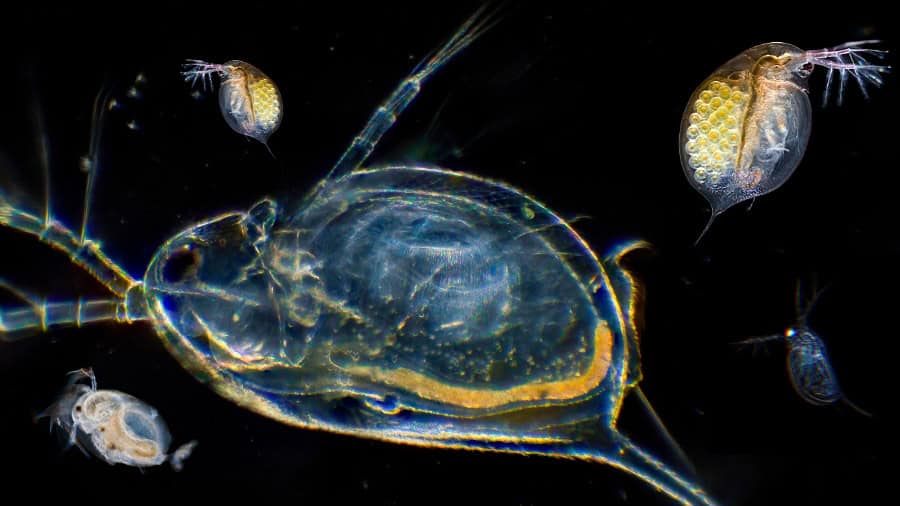How To Cultivate Daphnia (At Home)
These fast-growing plankton-like water fleas are excellent for feeding fish and other animals. Daphnia mature in 8 days and start breeding immediately, meaning an endless supply of live fish food. The adult size of daphnia is 3mm (0.12 inches).
Daphnia can be cultivated from eggs or a culture/starter. Here, I will explain how to use a starter culture.
Setting Up Your Daphnia Tank
The tank size depends on the size of the daphnia you want. Remember that each one has about ten babies. Because their life cycle is only a few months, they make the most of it and have babies every eight days. The numbers multiply quickly. You can start with a small six-gallon tank, but you will quickly realize the best is to start with the correct size tank.
The recommended size is a 55-gallon (208 L) tank, which will better handle the daphnia’s waste and avoid population crashes.
Freshwater plants like Duckweed work wonderfully in a Daphnia tank, keeping the water clean and helping the ecosystem flourish. The Duckweed will also help keep algae under control by using up some of the additional nutrients in the water.
Lights are crucial in a Daphnia tank. As they are photosensitive, lights must be on 24/7 for a happy and flourishing Daphnia tank.
A Daphnia tank needs an airstone to aerate the tank water and create a little flow. It is best to place the air stone in one corner of the tank so the Daphnia can move away from the flow if they want to.
A heater might be needed during winter months when it gets a bit colder in your area. The ideal temperature for a Daphnia tank is 20°C (68°F), and a heater might come in handy to avoid temperature fluctuations.
Prime or dechlorination drops are essential when setting up a Daphnia tank. The water must be dechlorinated to create a suitable environment for your new ecosystem of bacteria to flourish. Adding a Wonder Shell to the tank is another great option to boost the minerals and electrolytes in the water, help with dechlorination, and add hardness to the water.
You can add more fresh dechlorinated water each week to your Daphnia tank, as the water level will decrease due to evaporation. The more water changes you perform, the better Daphnia production you will see. You can remove 25% of the water weekly to make sure you keep the nitrite levels low.
Invertebrates like shrimps or snails would be a great addition to your Daphnia tank as they contribute to the natural ecosystem you are creating for them and help keep things clean in your tank.

What Do I Feed My Daphnia
Daphnia flourishes on active dry yeast, algae, and spirulina powder.
Active dry yeast can be purchased at any local grocery store. It’s the same yeast used for baking bread. Using a stick or immersion blender, combine dechlorinated water and yeast to create a fine, watery paste. This mixture can be added straight to the tank water.
Algae that will naturally grow in the tank because of all the nutrients in the water and the constant light can just be left in the tank. I like to be able to see into the tank, so I usually clean the front glass off with a scraper and leave the rest of the sides of the tank for the algae to continue growing.
You can sprinkle a good amount of spirulina powder on the tank’s water surface. The water will start to clear when the next feeding of spirulina powder and yeast mixture is due.
Adding green water to your daphnia tank helps provide your daphnia with extra nutrients and a natural probiotic as green water is made from adding too much beneficial bacteria to your tank water.
Daphnia are great water cleaners, so don’t be scared of overfeeding or adding too much food to the water, especially if they are reproducing; you will see how quickly your water will clear up.
How To Harvest Daphnia At Home
You will need an aquarium fish net which you will pass through the water around the surface. You can harvest enough to feed your aquarium fish their serving. The harvested Daphnia can be directly transferred from the net into the fish tank with the fish you want to feed.
It is very important to harvest frequently to prevent a population crash. Frequent harvesting helps reduce the numbers, reduces the waste in the water, and keeps the Daphnia alive long enough to reproduce.
